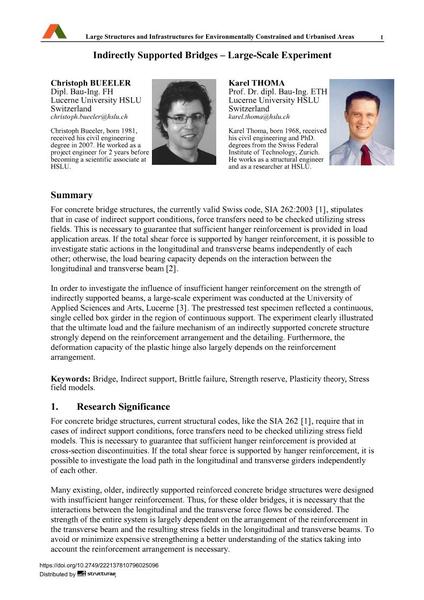Indirectly Supported Bridges – Large-Scale Experiment

|
|
|||||||||||
Bibliografische Angaben
| Autor(en): |
Christoph Bueeler
Karel Thoma |
||||
|---|---|---|---|---|---|
| Medium: | Tagungsbeitrag | ||||
| Sprache(n): | Englisch | ||||
| Tagung: | IABSE Symposium: Large Structures and Infrastructures for Environmentally Constrained and Urbanised Areas, Venice, Italy, 22-24 September 2010 | ||||
| Veröffentlicht in: | IABSE Symposium Venice 2010 | ||||
|
|||||
| Seite(n): | 406-407 | ||||
| Anzahl der Seiten (im PDF): | 8 | ||||
| Jahr: | 2010 | ||||
| DOI: | 10.2749/222137810796025096 | ||||
| Abstrakt: |
For concrete bridge structures, the currently valid Swiss code, SIA 262:2003 X[1]X, stipulates that in case of indirect support conditions, force transfers need to be checked utilizing stress fields. This is necessary to guarantee that sufficient hanger reinforcement is provided in load application areas. If the total shear force is supported by hanger reinforcement, it is possible to investigate static actions in the longitudinal and transverse beams independently of each other; otherwise, the load bearing capacity depends on the interaction between the longitudinal and transverse beam X[2]X. In order to investigate the influence of insufficient hanger reinforcement on the strength of indirectly supported beams, a large-scale experiment was conducted at the University of Applied Sciences and Arts, Lucerne X[3]X. The prestressed test specimen reflected a continuous, single celled box girder in the region of continuous support. The experiment clearly illustrated that the ultimate load and the failure mechanism of an indirectly supported concrete structure strongly depend on the reinforcement arrangement and the detailing. Furthermore, the deformation capacity of the plastic hinge also largely depends on the reinforcement arrangement. |
||||
| Stichwörter: |
Brücke Plastizitätstheorie
|
||||
